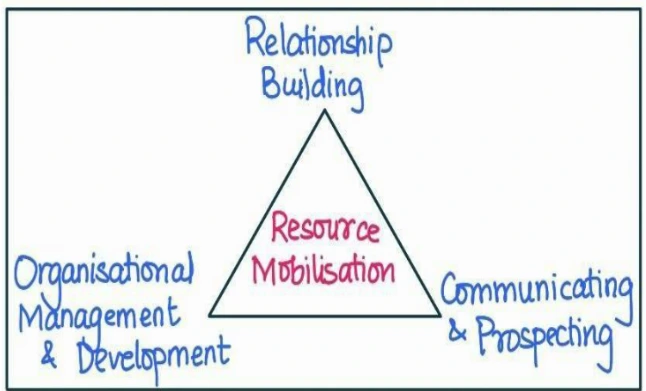Answer:
|
How to Approach the Question?
- Introduction
- Begin by defining resource mobilization and substantiate with an example.
- Body
- Discuss the significance of mobilizing resources for sustainable development in India.
- Briefly mention the associated challenges.
- Suggest innovative measures and policy interventions that can enhance resource mobilization while ensuring equitable growth and environmental preservation.
- Conclusion
- Conclude on a futuristic note.
|
Introduction
Resource mobilization refers to the process of gathering and utilizing resources, such as financial, human, and material, to achieve specific objectives or goals. For instance, the funds of the MPLADS scheme was diverted towards the PM-CARES fund in order to mobilize funds to tackle the COVID-19 pandemic in the country in an effective manner.
Body
Significance of Resource Mobilization for Sustainable Development of India:

- Creating jobs and boosting the economy: Resource mobilization through initiatives like the Pradhan Mantri Jan Dhan Yojana (PMJDY) can stimulate job creation and economic growth by investing in infrastructure, manufacturing, and services, while empowering the poor with access to credit and financial opportunities. Example-The total balance in PMJDY at the end of FY23 stood at ₹1.99 lakh crore.
- Reducing poverty and inequality: Resource mobilization, exemplified by programs like MGNREGA, can reduce poverty and inequality by investing in basic necessities, providing guaranteed employment and income to rural households, thereby promoting equity.
- Improving the quality of life: Resource mobilization, exemplified by SSA’s (Sarva Shiksha Abhiyan) investment in education, healthcare, and sanitation, significantly improves the quality of life for Indians, particularly children, through better educational opportunities.
- Protecting the environment: Resource mobilization, as demonstrated by the NCAP, can tackle environmental issues like air pollution, water scarcity, and deforestation through emission control measures, safeguarding the environment and public health.
- Building a strong and resilient nation: Mobilizing resources in defense, security, and disaster management, exemplified by PMSBY (Pradhan Mantri Suraksha Bima Yojana), contributes to a stronger and more resilient India through initiatives like providing life insurance to the poor.
- Building resilient infrastructure: A World Bank report estimates that India will need to invest $840 billion over the next 15 years in its infrastructure to witness sustainable and equitable growth. The Union Budget 2023-24 allocated Rs 10 Lakh crore for infrastructure development in the co weekuntry.
Challenges Associated with Resource Mobilization
- Limited public resources: India’s developing status and large population result in limited public highlighted by Transparency International’s ranking of India at 86th out of 180 countries in terms of corruption and lack of transparency and accountability in resource utilization.
- Lack of political will: Inadequate political will hampers resource mobilization for sustainable development, delaying crucial investments in areas like climate change, as seen in the dilution of EIA rules in the 2020 notification.
Suggestions to Enhance Resource Mobilization:
- Green Bonds: Introduce eco-friendly bonds to finance sustainable projects like afforestation, and waste management as India did in 2019 to finance renewable energy projects.
- Impact Investing: Promote impact investing, where investors seek financial returns and positive social or environmental impact, by supporting impact-focused funds and projects aligned with sustainable development goals. For example, the “Better Cotton Initiative” attracts funding from impact investors to promote sustainable cotton farming practices.
- Carbon Pricing: Implement pricing on emissions to promote cleaner technologies. The European Union’s Emissions Trading System is a successful case.
- Public-Private Partnerships (PPPs): Leverage private sector efficiency for green projects.
Delhi Metro is a notable example.
- Circular Economy Incentives: Promote circular economy incentives, like tax benefits or subsidies, to businesses adopting circular practices for resource efficiency and waste reduction. Sweden’s tax reduction on repair services is a prime example of incentivizing circular practices.
- Green Innovation Funds: Establish funds for green technology research. The UK’s Green Investment Bank is a model in this direction.
- Natural Capital Accounting: Introduce natural capital accounting to value environmental resources and ecosystem services, aiding decision-making. The World Bank’s WAVES program exemplifies its successful implementation.
- Sustainable Procurement Policies: Enforce sustainable procurement policies in government contracts to prioritize eco-friendly products and services, stimulating a market shift towards green technologies. The US General Services Administration’s Green Procurement Program is an example of promoting sustainable procurement.
- Green Tax Reforms: Incentivize sustainable practices and discourage polluting activities.
Norway’s tax breaks for electric vehicles are noteworthy here.
Conclusion:
By leveraging the appropriate measures for resource mobilization, we can shape a future where sustainable development is the cornerstone of our progress, ensuring a thriving, equal, and inclusive society while preserving the delicate balance of our planet for generations to come.
To get PDF version, Please click on "Print PDF" button.


Latest Comments